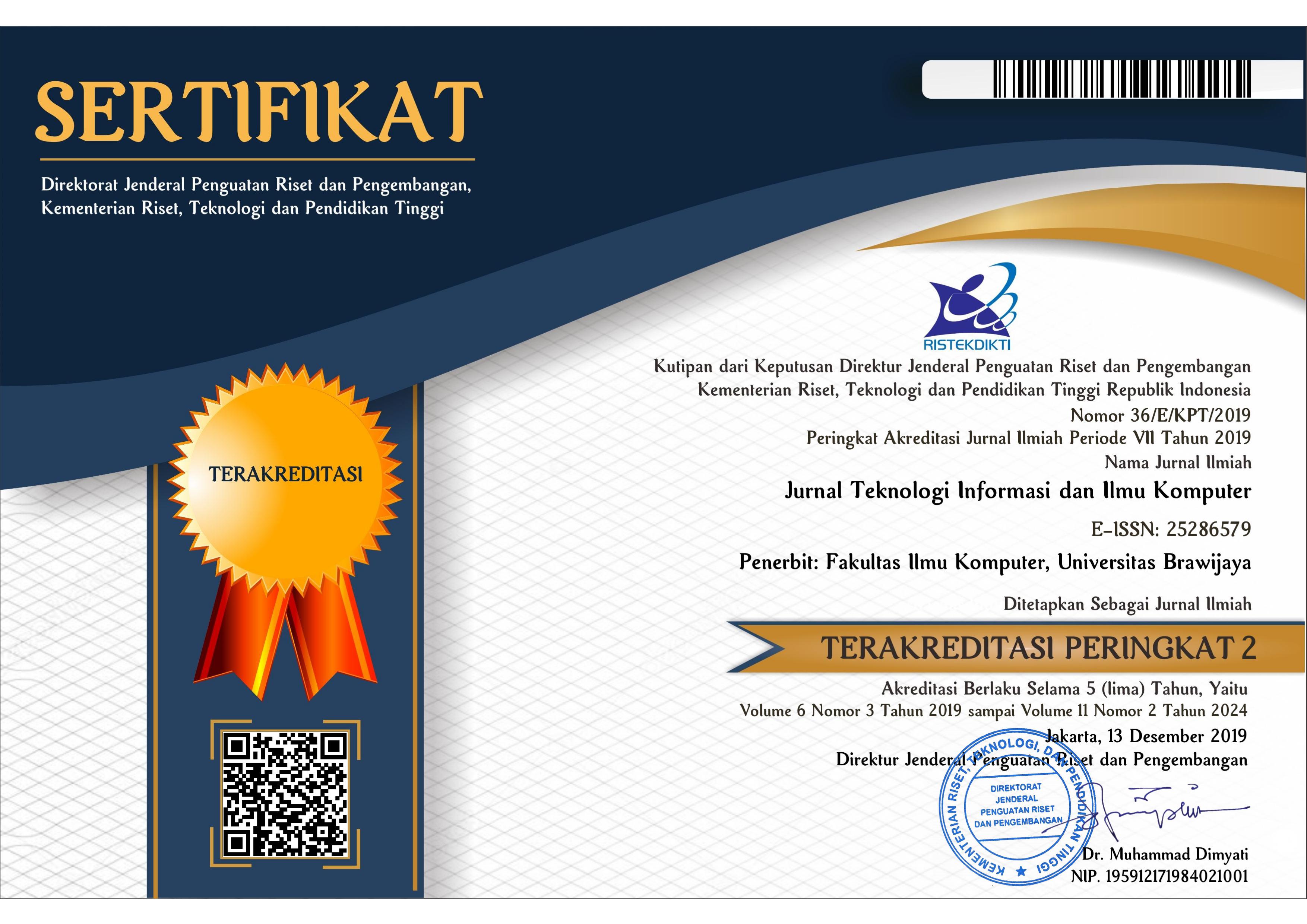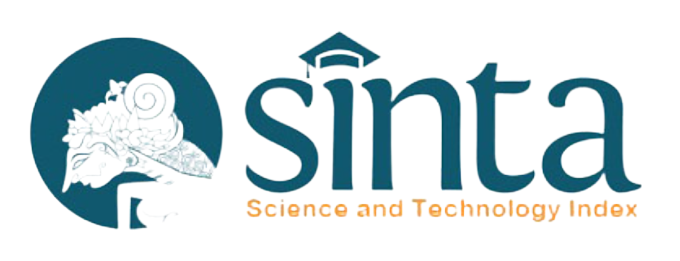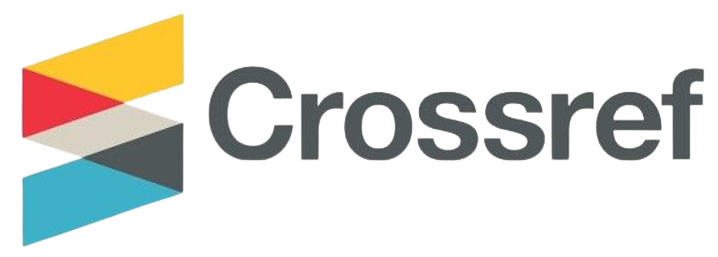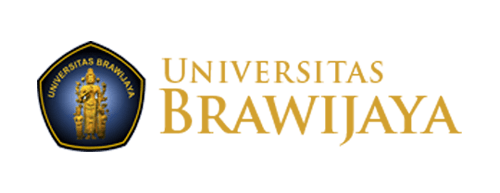Model Deep Learning untuk Klasifikasi Objek pada Gambar Fisheye
DOI:
https://doi.org/10.25126/jtiik.938047Kata Kunci:
Deep Learning, Convolution Neural Network, Layer, FisheyeAbstrak
Pengenalan suatu objek secara otomatis adalah suatu pekerjaan yang sangat penting seperti halnya untuk mengidentifikasi sebuah objek tertentu. Jika hal ini dilakukan oleh manusia maka akan sulit untuk mendapatkan hasil yang baik dengan konsisten, oleh sebab itu digunakan komputer. Komputer dapat mengenali objek selayaknya kemampuan manusia dalam mengenali objek, dengan cara mengamati gambar yang diperoleh dari kamera, dan menerapkan metode pengenalan pada gambar tersebut. Pada penelitian ini metode pengenalan objek akan dikembangkan dengan menggunakan kamera fisheye yang memiliki luas tangkap empat kali kamera konvensional. Metode pengenalan objek yang digunakan yaitu deep learning dengan arsitektur CNN (Convolution Neural Network). CNN memiliki kemampuan untuk mengenali objek dalam gambar. Model CNN yang digunakan terdiri dari 1 layer, 2 layer, 3 layer, dan 7 layer. Sedangkan untuk melatih dan memvalidasi model tersebut digunakan 900 gambar dataset. Hasil pengujian pada penelitian ini menunjukan bahwa pada 7 layer CNN menghasilkan nilai presisi, recall dan akurasi tertinggi dengan komposisi nilai presisi 98,56%, recall 98,5% dan akurasi 98,59%. Nilai tersebut menunjukan bahwa hasil klasifikasi terhadap ketiga klasifikasi objek gambar manusia pada gambar fisheye dapat dilakukan dengan sangat baik.
Abstract
Object recognition is an important method of identifying object in an image. If this method is carried out by the humans, it is difficult to work continuously, therefore, it can be done by a computer. The computer can recognize an object on an image taken from a camera as if a human if it is trained whit a certain dataset of be object. In this research, a method a recognizing object is developed by using images captured from a fisheye camera. This camera provides better field of view four times then confessional camera. The object recognition method relies on convolutional neural network architecture that has capability to recognize object on an image. The CNN model is developed in four types of models. The first model consists of 1 layer, while the second model consist of 2 layers. The thread model consists of 3 layers, while the last consist of 7 layers. The number of datasets used for training and testing each model is 900 images. The experiment results showed that the four model which consist of 7 layers provide the best result. This is confirmed by the number of precisions, recall, and accuracy, which reach 98,56%, 98,5%, and 98,59% respectively. This result means that can classify three different objects of human on fisheye images well.
Downloads
Referensi
ALAMSYAH, D. AND PRATAMA, D. 2020 ‘Implementasi Convolutional Neural Networks (CNN) Untuk Klasifikasi Ekspresi Citra Wajah Pada Fer-2013 dataset’, Jurnal Teknologi Informasi, 4(2), pp. 350–355. doi:10.36294/jurti.v4i2.1714.
DZAKY, A.T.R. 2021 ‘Deteksi Penyakit Tanaman Cabai Menggunakan Metode Convolutional Neural Network’, e-Proceeding of Engineering, 8(2), pp. 3039–3055.
GUNAWAN, D. and SeETIAWAN, H. 2022 ‘Convolutional Neural Network Dalam Citra Medis’, KONSTELASI: Konvergensi Teknologi dan Sistem Informasi, 2(2). doi:10.24002/konstelasi.v2i2.5367.
HERDIANTO, H. and NASUTION, D. 2023 ‘Implementasi Metode CNN Untuk Klasifikasi objek’, METHOMIKA Jurnal Manajemen Informatika dan Komputerisasi Akuntansi, 7(1), pp. 54–60. doi:10.46880/jmika.vol7no1.pp54-60.
LEE, S.-H. 2022 ‘A study on classification and detection of small moths using CNN model’, Computers, Materials & Continua, 71(1), pp. 1987–1998. doi:10.32604/cmc.2022.022554..
PUTRI, O.N. 2020 Implementasi Metode CNN dalam Klasifikasi Gambar Jamur pada Analisis Image Processing (Studi Kasus: Gambar Jamur dengan Genus Agaricus dan Amanita). thesis.
SUTEJO, M. F., SATYAWAN, A. S. and SISWANTI, S. D. 2022 “Face Classification of in 360 Degree Images (Fish Eye) Using Tensorflow”, Prosiding Seminar Nasional Sains Teknologi dan Inovasi Indonesia (SENASTINDO), 4, pp. 365-375. doi: 10.54706/senastindo.v4.2022.213.
KUSUMANINGRUM, T.F. 2018 Implementasi Convolution Neural Network (CNN) Untuk Klasifikasi Jamur Konsumsi Di Indonesia Menggunakan Keras (Studi Kasus : Jamur Kuping, Jamur Merang dan Jamur Tiram). thesis.
WANG, PIN, FAN, E. and WANG, PENG 2021 ‘Comparative analysis of image classification algorithms based on traditional machine learning and Deep Learning’, Pattern Recognition Letters, 141, pp. 61–67. doi:10.1016/j.patrec.2020.07.042.
Unduhan
Diterbitkan
Terbitan
Bagian
Lisensi
Hak Cipta (c) 2024 Jurnal Teknologi Informasi dan Ilmu Komputer

Artikel ini berlisensiCreative Commons Attribution-ShareAlike 4.0 International License.

Artikel ini berlisensi Creative Common Attribution-ShareAlike 4.0 International (CC BY-SA 4.0)
Penulis yang menerbitkan di jurnal ini menyetujui ketentuan berikut:
- Penulis menyimpan hak cipta dan memberikan jurnal hak penerbitan pertama naskah secara simultan dengan lisensi di bawah Creative Common Attribution-ShareAlike 4.0 International (CC BY-SA 4.0) yang mengizinkan orang lain untuk berbagi pekerjaan dengan sebuah pernyataan kepenulisan pekerjaan dan penerbitan awal di jurnal ini.
- Penulis bisa memasukkan ke dalam penyusunan kontraktual tambahan terpisah untuk distribusi non ekslusif versi kaya terbitan jurnal (contoh: mempostingnya ke repositori institusional atau menerbitkannya dalam sebuah buku), dengan pengakuan penerbitan awalnya di jurnal ini.
- Penulis diizinkan dan didorong untuk mem-posting karya mereka online (contoh: di repositori institusional atau di website mereka) sebelum dan selama proses penyerahan, karena dapat mengarahkan ke pertukaran produktif, seperti halnya sitiran yang lebih awal dan lebih hebat dari karya yang diterbitkan. (Lihat Efek Akses Terbuka).














